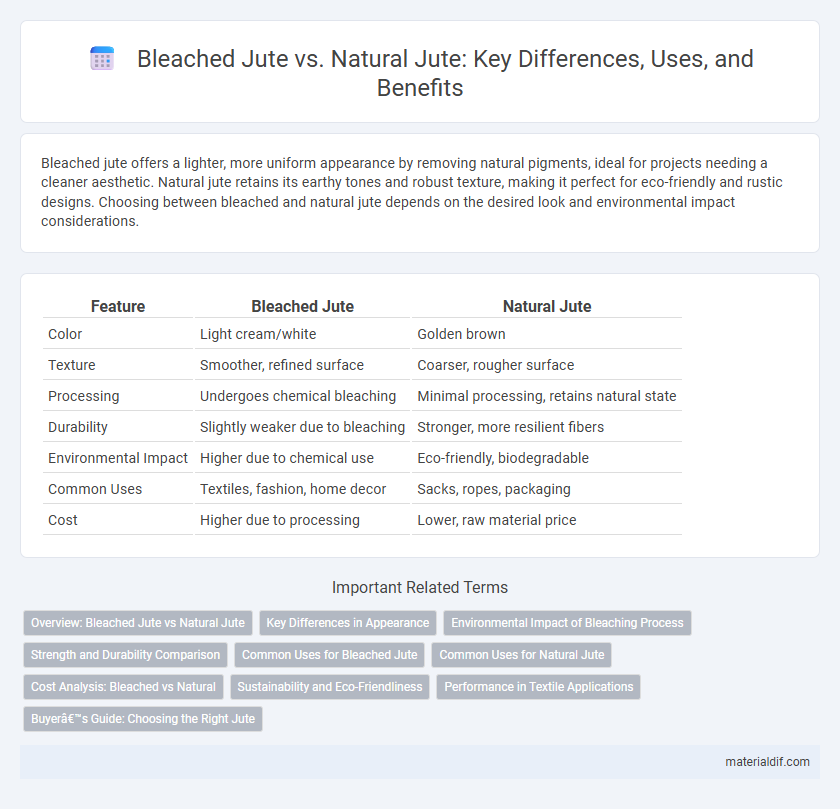Bleached jute offers a lighter, more uniform appearance by removing natural pigments, ideal for projects needing a cleaner aesthetic. Natural jute retains its earthy tones and robust texture, making it perfect for eco-friendly and rustic designs. Choosing between bleached and natural jute depends on the desired look and environmental impact considerations.
Table of Comparison
| Feature | Bleached Jute | Natural Jute |
|---|---|---|
| Color | Light cream/white | Golden brown |
| Texture | Smoother, refined surface | Coarser, rougher surface |
| Processing | Undergoes chemical bleaching | Minimal processing, retains natural state |
| Durability | Slightly weaker due to bleaching | Stronger, more resilient fibers |
| Environmental Impact | Higher due to chemical use | Eco-friendly, biodegradable |
| Common Uses | Textiles, fashion, home decor | Sacks, ropes, packaging |
| Cost | Higher due to processing | Lower, raw material price |
Overview: Bleached Jute vs Natural Jute
Bleached jute undergoes a chemical whitening process that enhances its appearance by removing natural color and impurities, making it ideal for aesthetic applications and products requiring a lighter shade. Natural jute retains its original earthy tone, offering a strong, biodegradable, and eco-friendly fiber preferred for traditional uses like sacks, ropes, and environmentally conscious packaging. The choice between bleached and natural jute depends on desired color uniformity, texture, and end-use requirements in textile and industrial fields.
Key Differences in Appearance
Bleached jute features a lighter, cream to off-white color due to the chemical treatment process that removes natural pigments, resulting in a more uniform and cleaner appearance. Natural jute retains its original golden-brown hue with visible fibers and a coarse texture, reflecting minimal processing and a rustic aesthetic. The bleaching process also slightly softens the fibers, making bleached jute more suitable for refined textile applications compared to the rougher, earthier look of natural jute.
Environmental Impact of Bleaching Process
The bleaching process of jute involves chemicals like chlorine and hydrogen peroxide, which can release harmful effluents into water bodies if not properly treated, leading to environmental pollution. Natural jute retains its fibers without chemical alteration, resulting in a lower carbon footprint and reduced water contamination compared to bleached jute. Choosing natural jute supports sustainable agriculture by minimizing chemical usage and preserving soil and water quality.
Strength and Durability Comparison
Bleached jute undergoes a chemical process that slightly reduces its natural fiber strength, making it less durable compared to natural jute, which retains its full tensile strength and resilience. Natural jute fibers exhibit superior durability in harsh environmental conditions due to their intact lignin and hemicellulose content, providing enhanced resistance to wear and tear. When selecting materials for heavy-duty applications, natural jute is preferred for its greater structural integrity and longer lifespan.
Common Uses for Bleached Jute
Bleached jute is commonly used in high-end home decor products such as rugs, wall coverings, and upholstery fabric due to its lighter color and smoother texture, which allows for easier dyeing and design customization. Its refined appearance makes it suitable for fashion accessories like bags and footwear, where aesthetic appeal is important. Additionally, bleached jute is favored in artisan crafts and gift packaging that require a clean, bright finish.
Common Uses for Natural Jute
Natural jute is widely used in eco-friendly packaging, agricultural sacks, and home decor items due to its biodegradable properties and coarse texture. It is commonly employed in making carpets, rugs, and upholstery fabric that require durability and a rustic appearance. Natural jute fibers also serve as insulation material and are popular in crafting bags and mats that emphasize sustainability.
Cost Analysis: Bleached vs Natural
Bleached jute incurs higher processing costs due to additional chemical treatments and labor required to achieve its lighter color, increasing its market price compared to natural jute. Natural jute remains more cost-effective, maintaining its raw, eco-friendly appeal with minimal processing expenses and lower environmental impact. Buyers often weigh these cost differences against aesthetic preferences and sustainability goals when selecting between bleached and natural jute products.
Sustainability and Eco-Friendliness
Bleached jute undergoes chemical processes to achieve its lighter color, which can introduce environmental concerns due to the use of harsh bleaching agents and increased water consumption. Natural jute retains its original fibers without chemical treatment, making it more sustainable and biodegradable with a lower ecological footprint. Choosing natural jute supports eco-friendly practices by minimizing pollution and preserving soil health through organic cultivation.
Performance in Textile Applications
Bleached jute offers enhanced color uniformity and brightness, making it ideal for textiles that require a clean and polished appearance, while natural jute retains higher tensile strength and durability due to minimal processing. The bleaching process can slightly weaken the fiber structure, impacting abrasion resistance but improving dye absorption and print clarity. For performance-driven textile applications, the choice depends on prioritizing visual aesthetics with bleached jute or maintaining robust mechanical properties with natural jute.
Buyer’s Guide: Choosing the Right Jute
Bleached jute offers a lighter, cleaner appearance suitable for decorative and fashion applications, while natural jute retains its coarse texture and rich, earthy hues favored in eco-friendly packaging and upholstery. Buyers should consider the end-use durability requirements and aesthetic preferences, as bleached jute undergoes chemical treatment that may reduce fiber strength compared to natural jute. Sustainability-conscious buyers often prefer natural jute due to its minimal processing and lower environmental impact, though bleached jute may better meet specific design and market demands.
Bleached Jute vs Natural Jute Infographic

 materialdif.com
materialdif.com